Cardiff pond maintenance, Carlsbad pond maintenance, Carmel Valley pond maintenance, Del Mar pond maintenance, Encinitas pond maintenance, La Costa pond maintenance, LaJolla pond maintenance, Leucadia pond maintenance, North County pond maintenance, Point Loma pond maintenance, Poway pond maintenance, Rancho Santa Fe pond maintenance, San Diego pond maintenance, and San Marcos pond Maintenance. North County Ponds and Rancho Santa Fe pond service. North County Ponds 760-710-1632 P.O. Box 8053 Rancho Santa Fe, California 92067. North County Ponds is north San Diego's best pond cleaning and pond maintenance service pond cleaning service. For a clean, healthy, beautiful pond, our pond maintenance is second to none. We are pond service professionals and are passionate about clean, healthy koi ponds. Let North County Ponds care for your koi pond. Keep your pond beautiful! Call us today for a free pond consultation: North County Ponds (760-710-1632) Dirty pond? North County Ponds is the answer for clearer, cleaner pond water, pond muck removal, aquatic plant management, pond algae control, pond filter and pond pump maintenance, pond equipment installation, koi health, pond health, and general pond and lake management. North County Ponds services the greater area of north San Diego county including: Rancho Santa Fe ponds, Del Mar ponds, La Jolla ponds, Carmel Valley ponds, Solana Beach ponds, Encinitas ponds, Carlsbad ponds, and Fallbrook ponds. |
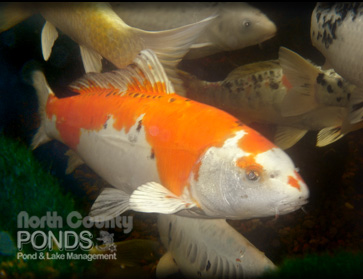 |
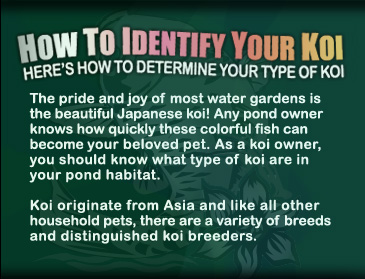 |
 |
|
|
 |
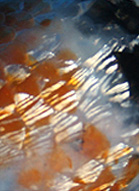 |
 |
| Ginrin scales are quite different from those on metallic koi. Instead of an overall gleam caused by the reflective pigment guanine, Ginrin scales have a reflective sheen over all or part of their surface creating a glimmering effect. The color they appear is determined by the pigment they overlay - silver (Gin) in the case of sumi or white, and golden (Kin) over hi. More than one type of Ginrin scale can appear on the same fish. Beta-Gin is usually found on the abdomen, along the lateral line or in individual rows toward the dorsal surface. Diamond and Kado-Gin tend to cover the back of the koi. Most hobbyists today do not differentiate between the types of Ginrin, but accept them as enhancing already beautiful koi. |
 |
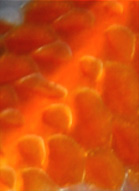 |
 |
| Metallic scales’ lustre is created through an abundance of colour cells that are excellent reflectors of light. Metallic koi pack in these reflective iridocytes into their skin, at the expense of losing the more intensely coloured chromatophores (or colour cells). Hence, these koi will rarely exhibit the same deep, solid, consistent reds and blacks equivalent non-metallic koi. Typically, judges form their opinions based on the shape and proportion of their body, the depth of the metallic sheen (referred to as lustre) and the clarity of the head will all count towards the quality of a metallic koi. |
 |
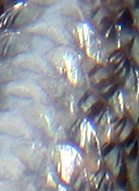 |
 |
| Even metallic fish are now being bred with this scalation and a good Ginrin Ogon is an unforgettable sight. To qualify as Ginrin, a koi should have more of these scales than it is possible to count as it swims past the observer - about 20 is the accepted minimum. Individual Ginrin scales on otherwise matt-scaled koi can look very attractive and do not detract from their value. A shimmering coat of reflective scales can lead the novice to fall for koi of otherwise limited attributes. Show judges in the Kin-Gin-Rin class, looking at a Ginrin Kohaku, will first ask themselves "Is this a good Kohaku in its own right?" Only if they are satisfied that it is will they mark it highly. |
 |
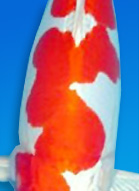 |
 |
| Doitsu (German-scaled fish) typically describes koi with no scales other than enlarged scales along the lateral line and two lines running on either side of the dorsal fin. In Japan, the Doitsu classification applies only to Go Sanke, while in Western shows there is no separate category for any German-scaled fish, with the exception of Shusui. However, the growing popularity of these virtually naked-skinned koi suggests that some revision may be necessary, so that Doitsu scalation can be recognized for what it is; an intriguing and challenging variation on the endless theme of Nishikigoi. There are a few Doitsu koi with their own names, such as Shusui and Kumonryu. Any other koi that would fit into a separate classification yet dons Doitsu scalage would have an extra prefix or suffix of "Doitsu" such as Doitsu Kohaku or Hariwake Doitsu. |
|
|
|
 |
| *Koi indentification information is courtesy of Blackwater Creek Koi Farms Inc. |
 |
| If your pond is new or old, large or small, North County Ponds is trained in a variety of pond care services including regular pond maintenance, on-call pond services, pond clean-outs, complete filter system installs, pond water treatments, system cleanings, pond sealing, koi medicating, koi and fish care, algae control, aquatic plant care, and all other aspects of pond and lake management. Call North County Ponds at 760-710-1632 for questions, pricing info, or to schedule a free pond consultation. |
 |
|
| Cardiff pond maintenance, Carlsbad pond maintenance, Carmel Valley pond maintenance, Del Mar pond maintenance, Encinitas pond maintenance, La Costa pond maintenance, LaJolla pond maintenance, Leucadia pond maintenance, North County pond maintenance, Point Loma pond maintenance, Poway pond maintenance, Rancho Santa Fe pond maintenance, San Diego pond maintenance, and San Marcos pond Maintenance. North County Ponds and Rancho Santa Fe pond service. North County Ponds 760-710-1632 P.O. Box 8053 Rancho Santa Fe, California 92067. North County Ponds is north San Diego's best pond cleaning and pond maintenance service pond cleaning service. For a clean, healthy, beautiful pond, our pond maintenance is second to none. We are pond service professionals and are passionate about clean, healthy koi ponds. Let North County Ponds care for your koi pond. Keep your pond beautiful! Call us today for a free pond consultation: North County Ponds (760-710-1632) Dirty pond? North County Ponds is the answer for clearer, cleaner pond water, pond muck removal, aquatic plant management, pond algae control, pond filter and pond pump maintenance, pond equipment installation, koi health, pond health, and general pond and lake management. North County Ponds services the greater area of north San Diego county including: Rancho Santa Fe ponds, Del Mar ponds, La Jolla ponds, Carmel Valley ponds, Solana Beach ponds, Encinitas ponds, Carlsbad ponds, and Fallbrook ponds. |







